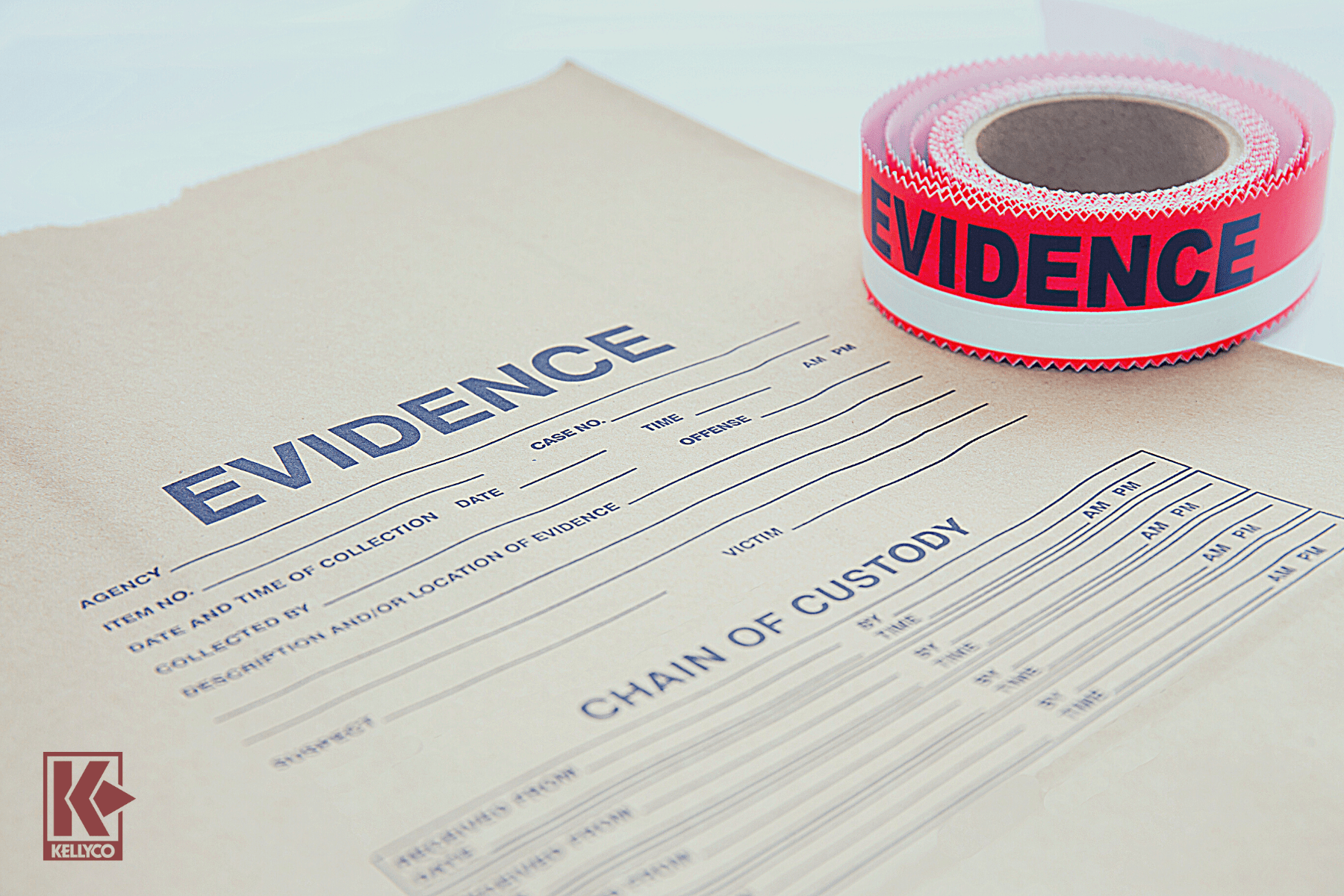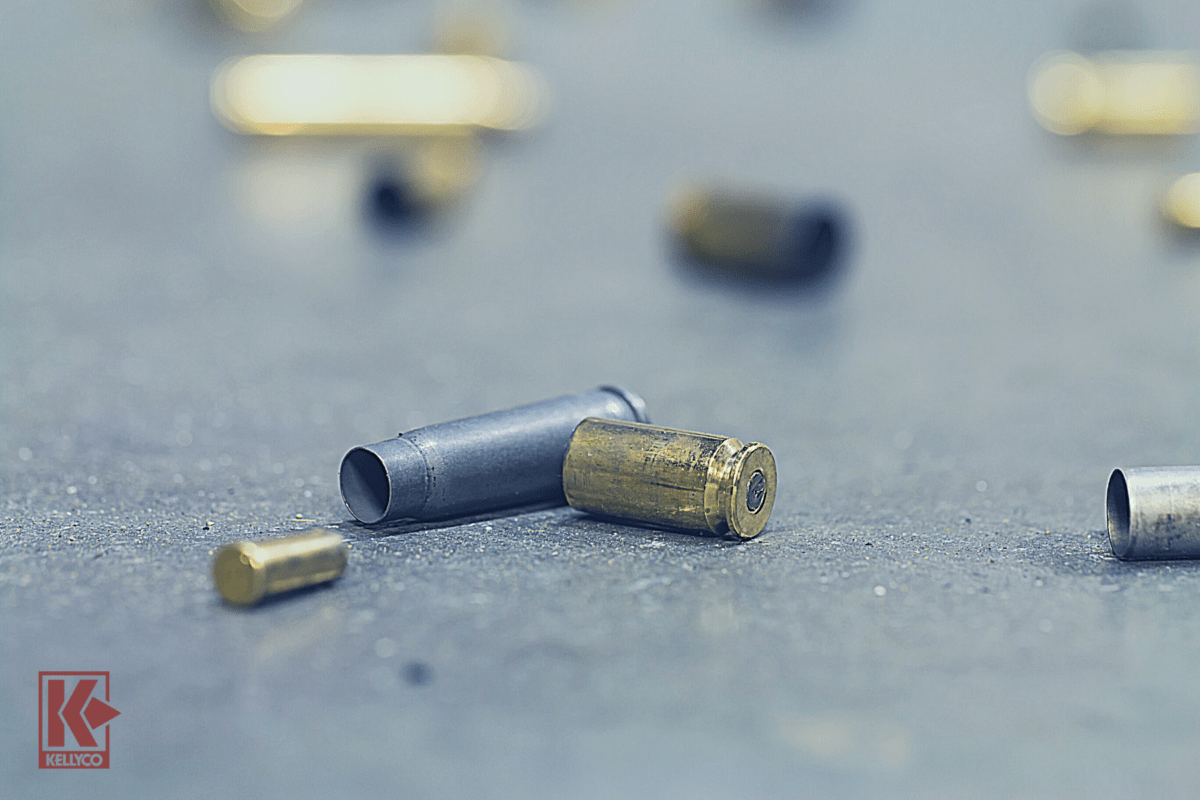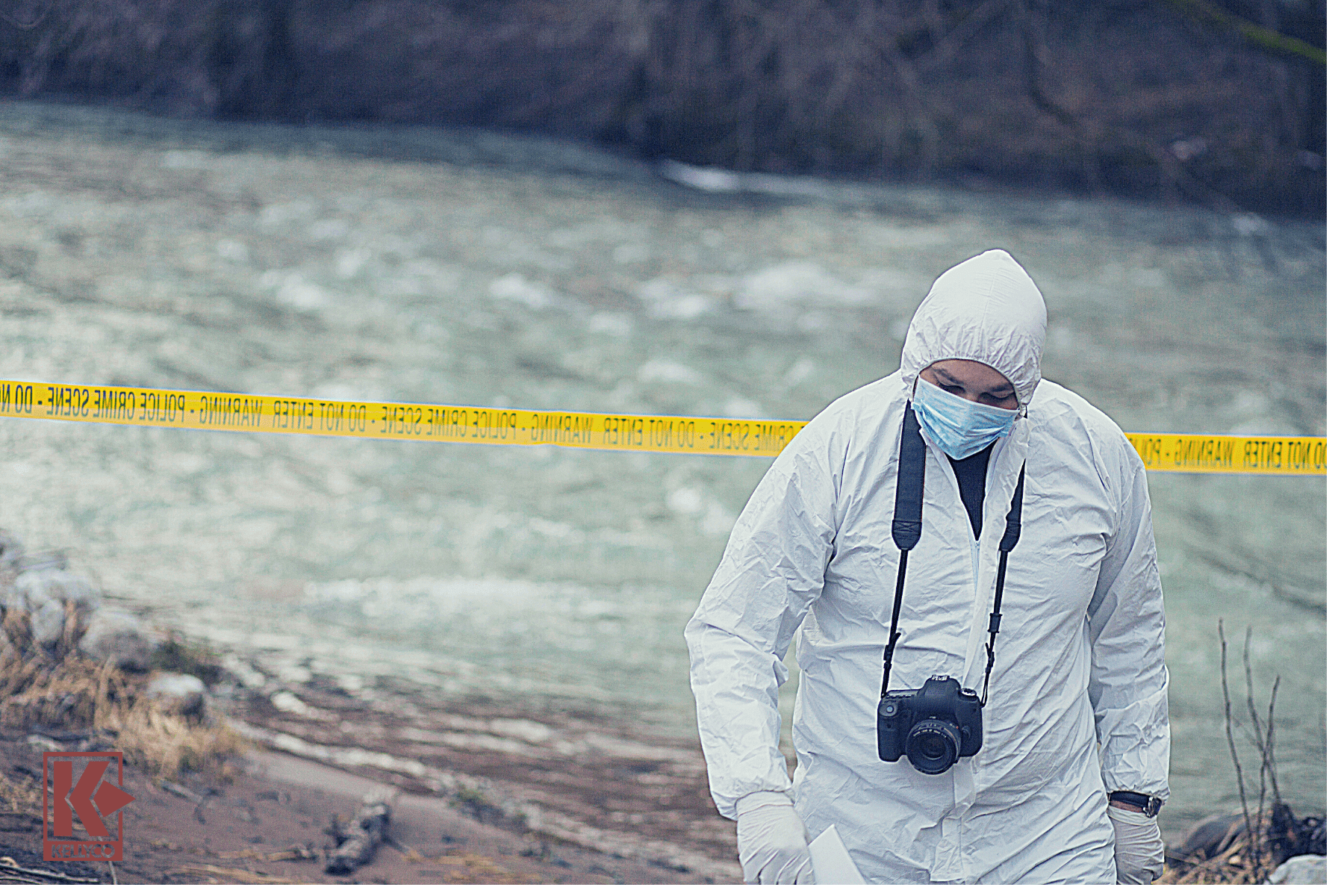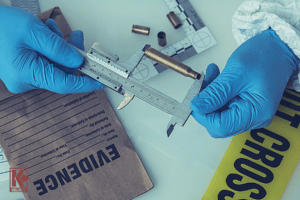Crime Scene Investigation and Evidence Collection
Published by Sam Jacobs on 02/12/21
Metal detectors aren’t just for hunting for gold. They’re also enormously useful tools for law enforcement. And yet, while most police departments have metal detectors on hand for crime scene investigation, far fewer have trained and qualified officers who know how to use them correctly. But when deployed properly, metal detectors can be a game-changer when it comes to effectively investigating a crime scene, uncovering evidence that might otherwise go detected while at the same time preserving a crime scene from disturbance.
The evidence of metal detectors’ effectiveness is conclusive: A study published in Law and Order found that “Automatic Very Low Frequency (VLF) ground canceling metal detectors have proven to be the best all-around choice for ground (land) searches in law enforcement applications.” This was attributed to “their ease of use and sensitivity.”
The use of metal detectors at crime scene investigations goes far back into history. In fact, a metal detector was used to uncover the round that was used in the assassination of President James Garfield.
Safety is another factor when it comes to using metal detectors. To use an obvious example, consider a hypodermic needle in the middle of a pile of leaves. A metal detector can help an officer to discover such evidence without him having to root around in the leaves risking injury — or worse.
When searching for weapons in a house, you can program a metal detector to ensure that it doesn’t read common objects in a wall or a floor. This makes it easier to find objects when they have been hidden with great care by a suspect.
There are tons of reasons for police departments to have metal detectors and use them with vigor. What’s more, it’s probably less expensive and easier to both purchase and train than you probably think.
Use It Or Lose It: Budgeting for a Metal Detector
We spoke to former police officer Dave Bachert. Dave has over 20 years of experience as a police officer, having served in Allentown, Pennsylvania as the Supervisor of the Evidence Unit. While serving in that capacity, he went out and purchased a metal detector for his department. He notes that one of the first things he mentions to police officers with department purchasing power is that their budgets are, more often than not, “use it or lose it.”
This means that the unspent budget will not rollover to the next year. And while many police departments find things to spend budget money on that are arguably frivolous, many don’t have metal detectors. So if there’s money sitting around at the end of the year — or even at the beginning — a metal detector is a wise investment that will not only uncover evidence that might otherwise go unseen but will also speed up the process of combing a crime scene investigation for evidence.
Without Proper Training, Your Metal Detector Is a Paperweight
Part of the reason that many departments don’t buy a metal detector or don’t use it is because they find the equipment to be intimidating. They might even have one, but no one wants to use it because they think it’s going to be too complicated and slow down the process. On the other hand, untrained officers using metal detectors might cease using them because they think that they don’t produce any meaningful results.
But training to properly use a metal detector is not a difficult task and virtually any officer can learn how to use a metal detector properly. Most of the time the reason an untrained officer found no luck using a metal detector was because of some very simple mistake that can easily be corrected. Once learned, it is incredibly easy to use and will only serve to cut the amount of time it takes to investigate a crime scene while at the same time producing far more thorough results.
If the department already has a metal detector, there’s little point in having it if it never leaves the office. After all, think about how much evidence you’re missing out on because officers aren’t bringing it out into the field to aid with their crime scene investigations?
 Proper training and knowledge of the equipment are crucial not only to detect and find evidence but also to make sure that the evidence, once found, will hold up in court. A skilled attorney can easily pick apart and discredit evidence found with a metal detector when the officer doesn’t understand the equipment or how it was used. On the other hand, an officer who is highly knowledgeable of and capable with his metal detector can withstand a great deal of scrutiny on the witness stand. This increases the chances of the evidence you find with a metal detector staying in the game when it comes to trial.
Proper training and knowledge of the equipment are crucial not only to detect and find evidence but also to make sure that the evidence, once found, will hold up in court. A skilled attorney can easily pick apart and discredit evidence found with a metal detector when the officer doesn’t understand the equipment or how it was used. On the other hand, an officer who is highly knowledgeable of and capable with his metal detector can withstand a great deal of scrutiny on the witness stand. This increases the chances of the evidence you find with a metal detector staying in the game when it comes to trial.
Knowing the manual, learning the terminology and basic operation of the metal detector is the bedrock, but it’s not the end of the story by any means. There’s no substitute for practice with a metal detector. That practice doesn’t have to be, and ultimately shouldn’t be, limited to practice in the field. Officers should, for example, take a metal detector to the shooting range. This gives them the opportunity to examine a number of spent shell casings to learn the difference between how a metal detector registers one versus another.
From there, officers can proceed to more complex tasks like finding shell casings and spent round that are underneath three inches of soil. This kind of training shouldn’t be an obstacle to getting the metal detector out in the field. It should simply be there to supplement what the officers are doing during actual crime scene investigations.
Metal Detectors Are Snipers, Not Shotgunners
Some might think that there’s going to be a lot of false positives when using metal detectors for a crime scene investigation, but this is not the case. Dave notes that a metal detector can be set so that it only detects the specific type of metal in the caliber of ammunition that you’re looking for. So, for example, if you know that you’re looking for a steel-cased 9mm round, you can set the metal detector to only report results for that type of metal. What’s more, you can set the bandwidth so that it isn’t reporting common items like gum wrappers that might set off a metal detector.
One common method used when searching for evidence using a metal detector is to very narrowly set the metal detector so that it only returns results for a specific item that you are looking for. Once an area has been swept in this manner, an officer can then go over the same area casting a wider net. This allows for an officer to find specifically what he is looking for before searching the same area to see if there is anything that he missed that he wasn’tlooking for.
 The gun range allows officers to acquaint themselves with the nuances of a metal detector. For example, what kind of alert does one get from a 9mm as opposed to a .40 or a .44 magnum shell casing? You don’t need a crime scene investigation to do this. All you need are a bunch of empty shell casings.
The gun range allows officers to acquaint themselves with the nuances of a metal detector. For example, what kind of alert does one get from a 9mm as opposed to a .40 or a .44 magnum shell casing? You don’t need a crime scene investigation to do this. All you need are a bunch of empty shell casings.
Field experience, however, will be the gold standard when it comes to learning how to use the metal detector. While basically anyone can be trained to find empty shell casings and spent rounds, there’s a nearly unlimited amount of objects that could be found at a crime scene investigation that could end up being meaningful evidence. Indeed, as many crime scene investigators might attest, sometimes the most unassuming object can be a piece of evidence when the context is understood.
Finding such “odd” objects in a crime scene investigation is more art than science. Officers will just have to learn how to separate the wheat from the chaff through direct personal experience using metal detectors on crime scene investigations.
So what is a metal detector going to pick up at a crime scene that a trained investigator won’t? You’d be surprised. Dave reports finding guns and knives with his that investigators failed to locate on visual inspection of a crime scene. But beyond that, there are, of course, shell casing and even spent round that can be identified. This begins the process of forensic analysis of a crime scene. Once such a shell casing or a spent round is uncovered, laboratory analysis can begin to find out, with shocking specificity, precisely what kind of round it was before it was shot based on where contact with the primer occurs and what kind of rifling left its mark. This is a common method of matching guns to a crime, but it can’t take place if there’s no spent round or shell casing to examine.
A car might not sound like a very difficult object to find, but it would be if it was buried deep down. A metal detector in the hands of a skilled crime scene investigator, however, can detect an automobile as deep as 20 feet below the surface. This will uncover evidence that virtually any crime scene investigator, no matter how experienced, would miss even upon close inspection of an area.
Metal Detectors Help Preserve a Crime Scene Investigation
Metal detectors also reduce the impact on and disturbance of a crime scene. When locating and acquiring evidence from a crime scene, even skilled investigators can find that they unintentionally disturb the area. This is especially common outdoors, where natural terrain must, almost by the very nature of the process, be disturbed while officers are looking for evidence. Metal detectors, however, can significantly reduce or even eliminate the disturbance of crime scenes. Officers don’t have to get down on the ground to poke around for shell casings — they can simply wave the metal detector over the area and it will let them know if the shell casing is there.
It’s not just police officers who can assist with crime scene investigations using metal detectors, either. There are also legions of willing amateurs who are happy to help. Metal detecting clubs offer a ready-made army of amateur investigators who are willing to bring their tools to the search. There is some degree of training involved to ensure that the volunteers know how to not disturb crime scenes. But once you have these amateurs trained, you will be able to exponentially expand your ability to search a crime scene and uncover evidence.
Underwater Crime Scene Investigation and Metal Detectors
 Another area where metal detectors can help is with finding evidence underwater. This is a particularly shrewd investment of time and money for coastal police departments. Finding evidence underwater can be a seriously Sisyphian task, often yielding little in the way of results. But with a water-ready metal detector in tow, it can be far easier to unearth useful evidence from a crime scene. Officers must be trained in the proper use of such, as should volunteers. But this training isn’t nearly as time-consuming as one might think. And once the training has been implemented it can be used time and again, paying dividends almost immediately.
Another area where metal detectors can help is with finding evidence underwater. This is a particularly shrewd investment of time and money for coastal police departments. Finding evidence underwater can be a seriously Sisyphian task, often yielding little in the way of results. But with a water-ready metal detector in tow, it can be far easier to unearth useful evidence from a crime scene. Officers must be trained in the proper use of such, as should volunteers. But this training isn’t nearly as time-consuming as one might think. And once the training has been implemented it can be used time and again, paying dividends almost immediately.
One way to explore an underwater crime scene without disturbing either the scene itself or the ecosystem is to deploy the search team, who then simply use little markers known as “pingers” to mark an area in need of further exploration. The area can then be handed over to people who specialize in this sort of excavation.
Underwater metal detectors come in a variety of models, including ones for saltwater, which reduces the number of false positives. Others can be towed behind a boat, removing the need for skilled divers to investigate an area.
Underwater metal detectors need to be specially designed so that they ignore things like saltwater and black sand, which can trigger false positives. But the right metal detector with the right settings in the hands of a law enforcement officer who knows how to use it will uncover objects underwater that likely would otherwise have gone undetected.
Metal Detectors Help Solve Crimes When Other Tools Fail
As amazing as it sounds, this type of physical evidence was once thought of as nothing more than mostly uninteresting useless debris around a crime scene investigation. But now they are much more easily connected with evidence from crime scenes. And while fingerprints are not a magic bullet, they can often be taken from shell casings. There are also serial numbers on all rounds made after the 1968 Gun Control Act, adding another means of tracing and tracking shells found at a crime scene investigation.
How much can a little piece of metal found in a tree tell you about a crime? A heck of a lot, actually. Even a little fragment of a bullet has rifling details on it that begin to paint a picture of what ammunition was used. The caliber of a standard round or the gauge of a shotgun, for example. From here, skilled crime scene investigators can begin to deduce what brand of ammunition was used. This, in turn, begins to form a picture of which specific weapon was used when committing a crime.
A metal detector can find spent rounds in places that even skilled crime scene investigators comb-over for weeks. Oftentimes, these can be found embedded into some kind of wood. But even knowing that, searching for the spent round is a bit like the proverbial needle in a haystack. Keeping with this analogy, however — it’s a lot easier to find a needle in a haystack when you have a metal detector to help you get the job done. What’s more, when a metal detector is used it allows for better preservation of the area where the spent round is found. Thus, two pieces of evidence can be yielded through such methods.

There are rather astonishing real-world cases of forensic analysis matching up a weapon to a spent round or shell casing found at the scene of a crime. A man who was known to Philadelphia police as the Ruthless Robber was a dangerous menace who would rob his victims, then shoot at them after they had handed over their valuables. And without the kind of forensic evidence we’re talking about here, they never would have matched up one of his shell casings to a weapon that was recovered at a totally unrelated traffic stop.
In another case in Phoenix, Cleophus Cooksey Jr. was arrested for a double homicide. Within 48 hours they had him tied to seven other homicides, with police confident that they had caught a budding serial killer before he had a chance to really hit his stride.
Finally, there is the case in Colorado Springs, where a police department was having a bear of a time solving a series of crimes in the area, including a drive-by shooting at a local mall. What police were able to deduce from a large number of shell casings and spent rounds paired with forensic analysis is that several gang members were sharing a single “community gun.” Without a large amount of data to work with, there is no way that these homicides would ever have been solved.
The point here is that the more evidence you can collect, the better. While what you find might not be completely germane to your investigation, it might be helpful in another one. This is especially true if you live in a state where you have access to a statewide database of spent shell casings. And with a metal detector, you are certainly going to uncover more pieces of evidence with less crime scene disturbance than you would without one.
Another example of the role that metal detectors can plan in getting a conviction is the common pastime of joyriders shooting at stop signs. The recovered shells from such incidents might not attract a lot of notice without forensic analysis. However, with forensic analysis, police departments can begin matching the spent rounds and shell casings up to much more serious crimes that are oftentimes totally unrelated.
There are sweeping changes happening with law enforcement thanks to the revolution in forensic analysis. It was, and to a certain extent still is, uncommon for police to be able to solve non-fatal shootings. This is because of the amount of time, energy, and resources that have to go into these cases that oftentimes are better spent on fatal shootings.
Modern forensic analysis, however, makes it much easier to get the information needed to get a conviction from a piece of evidence such as a single shell recovered at the scene of the crime. A metal detector, in the hands of an officer properly trained on how to use it, will help to expand the evidence pool, allowing for greater convictions of all crimes, non-fatal shootings included.
What’s more, the man-hours involved in collecting evidence from a non-fatal shooting is significantly reduced when one has a metal detector on hand. The technology works from both directions to make investigating non-fatal crime scenes much more appealing even to smaller police departments with modest budgets: Better forensic analysis makes it easier to use the evidence provided, incentivizing collection. Better tools, such as metal detectors, make it easier to collect evidence in the first place, making the barrier to going out and collecting evidence lower.
But the important thing to remember with all of this is that there has to be proper training. Training isn’t complicated or arcane — if you made it through the police academy, you can learn how to properly use a metal detector. But the training has to be done right at the beginning to ensure that officers are finding what they are looking for and not becoming frustrated by a series of false positives. Once this training is done and the metal detector comes into common use during crime scene investigation, officers will likely wonder how they ever got by without one in the past.
